最新-浅谈汉语言文字的歧义现象 精品
- 格式:docx
- 大小:13.03 KB
- 文档页数:3
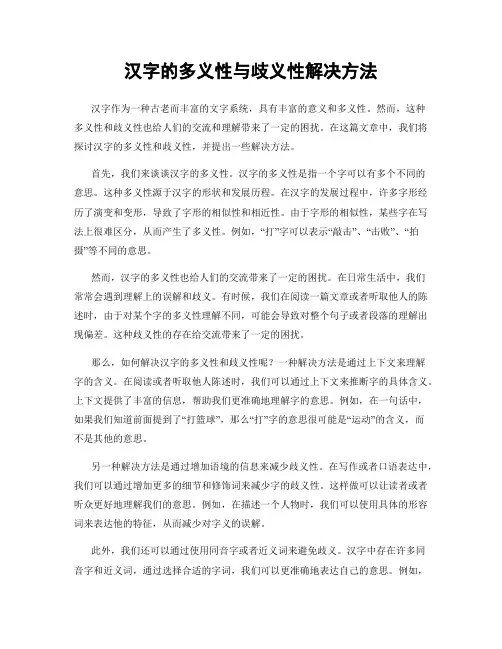
汉字的多义性与歧义性解决方法汉字作为一种古老而丰富的文字系统,具有丰富的意义和多义性。
然而,这种多义性和歧义性也给人们的交流和理解带来了一定的困扰。
在这篇文章中,我们将探讨汉字的多义性和歧义性,并提出一些解决方法。
首先,我们来谈谈汉字的多义性。
汉字的多义性是指一个字可以有多个不同的意思。
这种多义性源于汉字的形状和发展历程。
在汉字的发展过程中,许多字形经历了演变和变形,导致了字形的相似性和相近性。
由于字形的相似性,某些字在写法上很难区分,从而产生了多义性。
例如,“打”字可以表示“敲击”、“击败”、“拍摄”等不同的意思。
然而,汉字的多义性也给人们的交流带来了一定的困扰。
在日常生活中,我们常常会遇到理解上的误解和歧义。
有时候,我们在阅读一篇文章或者听取他人的陈述时,由于对某个字的多义性理解不同,可能会导致对整个句子或者段落的理解出现偏差。
这种歧义性的存在给交流带来了一定的困扰。
那么,如何解决汉字的多义性和歧义性呢?一种解决方法是通过上下文来理解字的含义。
在阅读或者听取他人陈述时,我们可以通过上下文来推断字的具体含义。
上下文提供了丰富的信息,帮助我们更准确地理解字的意思。
例如,在一句话中,如果我们知道前面提到了“打篮球”,那么“打”字的意思很可能是“运动”的含义,而不是其他的意思。
另一种解决方法是通过增加语境的信息来减少歧义性。
在写作或者口语表达中,我们可以通过增加更多的细节和修饰词来减少字的歧义性。
这样做可以让读者或者听众更好地理解我们的意思。
例如,在描述一个人物时,我们可以使用具体的形容词来表达他的特征,从而减少对字义的误解。
此外,我们还可以通过使用同音字或者近义词来避免歧义。
汉字中存在许多同音字和近义词,通过选择合适的字词,我们可以更准确地表达自己的意思。
例如,当我们在描述一个人的性格时,可以使用“坚强”来代替“强硬”,以避免产生不必要的歧义。
最后,我们还可以通过提高汉字的认知能力来解决多义性和歧义性。
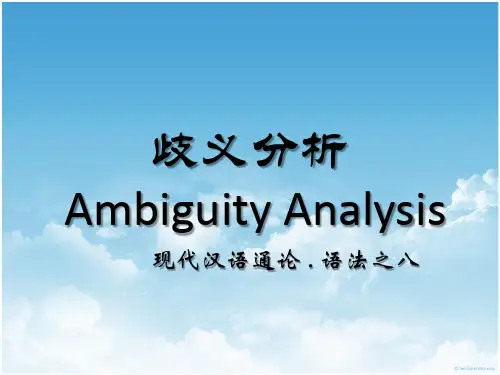
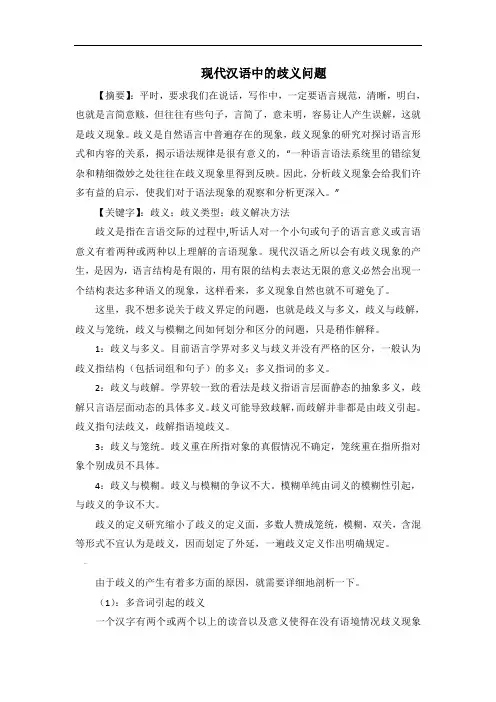
现代汉语中的歧义问题【摘要】:平时,要求我们在说话,写作中,一定要语言规范,清晰,明白,也就是言简意赅,但往往有些句子,言简了,意未明,容易让人产生误解,这就是歧义现象。
歧义是自然语言中普遍存在的现象,歧义现象的研究对探讨语言形式和内容的关系,揭示语法规律是很有意义的,“一种语言语法系统里的错综复杂和精细微妙之处往往在歧义现象里得到反映。
因此,分析歧义现象会给我们许多有益的启示,使我们对于语法现象的观察和分析更深入。
”【关键字】:歧义;歧义类型;歧义解决方法歧义是指在言语交际的过程中,听话人对一个小句或句子的语言意义或言语意义有着两种或两种以上理解的言语现象。
现代汉语之所以会有歧义现象的产生,是因为,语言结构是有限的,用有限的结构去表达无限的意义必然会出现一个结构表达多种语义的现象,这样看来,多义现象自然也就不可避免了。
这里,我不想多说关于歧义界定的问题,也就是歧义与多义,歧义与歧解,歧义与笼统,歧义与模糊之间如何划分和区分的问题,只是稍作解释。
1:歧义与多义。
目前语言学界对多义与歧义并没有严格的区分,一般认为歧义指结构(包括词组和句子)的多义;多义指词的多义。
2:歧义与歧解。
学界较一致的看法是歧义指语言层面静态的抽象多义,歧解只言语层面动态的具体多义。
歧义可能导致歧解,而歧解并非都是由歧义引起。
歧义指句法歧义,歧解指语境歧义。
3:歧义与笼统。
歧义重在所指对象的真假情况不确定,笼统重在指所指对象个别成员不具体。
4:歧义与模糊。
歧义与模糊的争议不大。
模糊单纯由词义的模糊性引起,与歧义的争议不大。
歧义的定义研究缩小了歧义的定义面,多数人赞成笼统,模糊,双关,含混等形式不宜认为是歧义,因而划定了外延,一遍歧义定义作出明确规定。
—由于歧义的产生有着多方面的原因,就需要详细地剖析一下。
(1):多音词引起的歧义一个汉字有两个或两个以上的读音以及意义使得在没有语境情况歧义现象的产生,比如说“都”,没有一定的语境,谁也不知道它到底是什么意思,是“dou”呢,还是“du”呢这种歧义只能用词音分析法,也就是组成词,换成“都是”,“首都”就可以理解了。

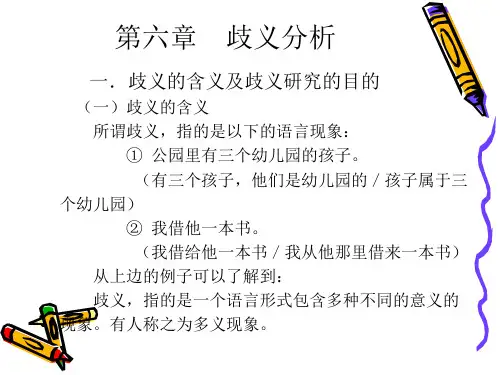
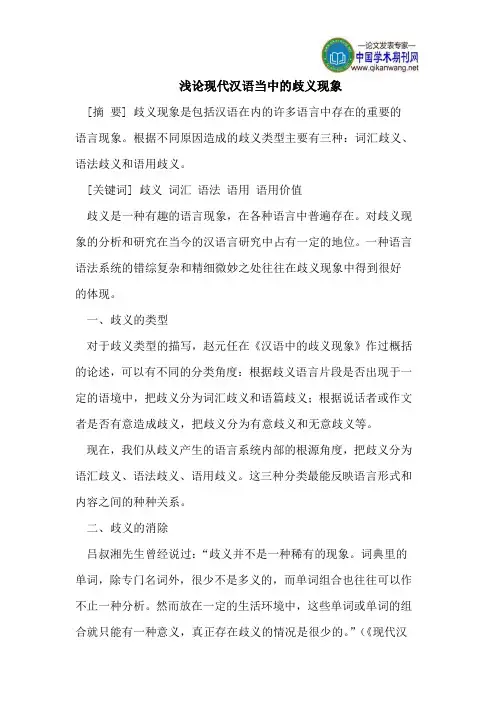
浅论现代汉语当中的歧义现象[摘要] 歧义现象是包括汉语在内的许多语言中存在的重要的语言现象。
根据不同原因造成的歧义类型主要有三种:词汇歧义、语法歧义和语用歧义。
[关键词] 歧义词汇语法语用语用价值歧义是一种有趣的语言现象,在各种语言中普遍存在。
对歧义现象的分析和研究在当今的汉语言研究中占有一定的地位。
一种语言语法系统的错综复杂和精细微妙之处往往在歧义现象中得到很好的体现。
一、歧义的类型对于歧义类型的描写,赵元任在《汉语中的歧义现象》作过概括的论述,可以有不同的分类角度:根据歧义语言片段是否出现于一定的语境中,把歧义分为词汇歧义和语篇歧义;根据说话者或作文者是否有意造成歧义,把歧义分为有意歧义和无意歧义等。
现在,我们从歧义产生的语言系统内部的根源角度,把歧义分为语汇歧义、语法歧义、语用歧义。
这三种分类最能反映语言形式和内容之间的种种关系。
二、歧义的消除吕叔湘先生曾经说过:“歧义并不是一种稀有的现象。
词典里的单词,除专门名词外,很少不是多义的,而单词组合也往往可以作不止一种分析。
然而放在一定的生活环境中,这些单词或单词的组合就只能有一种意义,真正存在歧义的情况是很少的。
”(《现代汉语研究和探索》(三)第13页,北京大学出版社,1985)这是因为我们可以运用一定的手段,利用一定的环境来消除歧义。
消除歧义的手段大致有以下几种方法。
(—)利用语音1.轻声。
轻声可以帮助区别词性和词义,有时还能区别不同的语法关系。
例如:⑴他爬过山没有?⑵我想起来了。
例⑴“过”读去声是趋向动词,读轻声是动态助词,意思不一样。
例⑵“起来”不读轻声时,与“想”构成述宾关系,全句意思是“我不想睡了”;“起来”读轻声时,与“想”构成述补关系,全句意思是“我刚才忘了,现在想起来了”。
2.重音。
重音可以显示强调的重点,利用重音可以明确语法成分的语义指向。
例如:“他最喜欢游泳。
”(“最”语义指向“他”,句意为“那些人当中,他最喜欢游泳。
”)3.停顿。

语句歧义现象的探讨(网友来稿)银川二十五中学高二年级组薄祥麟语句歧义现象是比较复杂的,它涉及到语音、语义、语法等诸多方面的问题。
一、语句歧义现象的内涵语句歧义现象是指一个语言单位含有两个或两个以上意义的现象。
歧义短语只是其中的一个方面(胡裕树主编的《现代汉语》)。
歧义现象在口语中的存在没有在书面语中出现的那么普遍,口语中的歧义现象主要是由于说话的环境和表意不明造成的,而书面语中的情形则复杂得多。
交际中,对语言的要求是简明、连贯、得体,“简明”的含义是“简要”、“明白”,其中的“明白”的意思是表达的内容要明白无误,让人准确理解其含义,不要产生歧义,而影响交际的效果。
歧义就是表意不明,甚至会造成语病。
1、讲台上只有一架收音机,一边还站着一个人。
该句中的“一边”是个多义词,既可表示“其中一边”,也可表示“每一边”。
这两个意义同时并存,从而产生歧义。
2、热爱人民的总理在这个短语中,我们不能因为它只有一种语言形式,而忽略其组合的方式。
其组合的方式实际有两种:A.热爱人民的总理动宾偏正B.热爱人民的总理偏正动宾两种不同的组合方式,亦即两种不同的结构层次,所表达的意义也不同:A句的意思是“总理热爱人民”,B句的意思是“人民热爱总理”。
二、语句歧义现象的诸种类型(一)词语的兼类和多义1、词语兼类黎锦熙老先生说:“词无本品,依句辨品。
”“品”即词类。
用动态的眼光来看词性是很有实际意义的。
词语兼类是指一个词具有两种或两种以上的词性。
在语言的实际运用中,词语兼类的情况非常普遍。
1、我要热饭。
在这个语言单位里,“热”可以是形容词,也可活用为动词。
既可表示“我要什么东西”的意思,也可表示“我要做什么”的意思。
该句中的结构实际上也是两种:A.我要热饭偏正动宾主谓B.我要热饭偏正动宾主谓2、词语多义我们知道,单义词在汉语词汇中是少数,而词语的多义性是其词语的特点。
在一定的语言环境中,多义词可以受到某些限定,很少发生歧义现象。
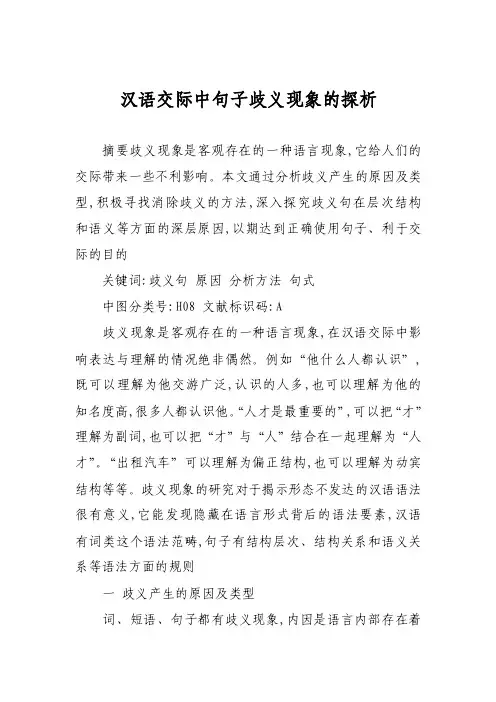
汉语交际中句子歧义现象的探析摘要歧义现象是客观存在的一种语言现象,它给人们的交际带来一些不利影响。
本文通过分析歧义产生的原因及类型,积极寻找消除歧义的方法,深入探究歧义句在层次结构和语义等方面的深层原因,以期达到正确使用句子、利于交际的目的关键词:歧义句原因分析方法句式中图分类号:H08 文献标识码:A歧义现象是客观存在的一种语言现象,在汉语交际中影响表达与理解的情况绝非偶然。
例如“他什么人都认识”,既可以理解为他交游广泛,认识的人多,也可以理解为他的知名度高,很多人都认识他。
“人才是最重要的”,可以把“才”理解为副词,也可以把“才”与“人”结合在一起理解为“人才”。
“出租汽车”可以理解为偏正结构,也可以理解为动宾结构等等。
歧义现象的研究对于揭示形态不发达的汉语语法很有意义,它能发现隐藏在语言形式背后的语法要素,汉语有词类这个语法范畴,句子有结构层次、结构关系和语义关系等语法方面的规则一歧义产生的原因及类型词、短语、句子都有歧义现象,内因是语言内部存在着大量同音词、多义词、兼类词和同形结构等,外因有交际场合、背景、听话人敏感程度、社会经历、文化程度、联想能力等。
主要包括以下几种类型(一)语音方面1 同音词在口语和书面语中都可能产生歧义例①:我想起来了a.“起来”读“qǐlái”时,表示“我想起身了”;b“起来”读“qǐlai”时,表示“我想到了”2 多音词在书面语中由于没有注音,常会产生歧义例②:到1999年底,他还欠款1000元a.“还”读“hái”指“仍旧”,表示“他仍然欠款1000元”;b.“还”读“huán”指“归还”,表示“他归还了欠款1000元”3 不同的语音停顿显示出的语意和结构往往不同而造成歧义例③:我们两个人分一个西瓜a.“我们/两个人分一个西瓜。
”表示“我们每两个人分一个西瓜。
”b.“我们两个人/分一个西瓜。
”表示“我们两个人合分一个西瓜。
”(二)词义方面1 多义词造成的歧义例④:我就管他a.“就”表示“只”;b.“就”表示“偏”2 兼类词造成的歧义例⑤:这辆车没有锁a.“锁”为名词,表示“这辆车没有配锁”;b.“锁”为动词,表示“这辆车没有锁上”(三)语法方面1 结构关系不同造成的歧义例⑥:昨天没有学习文件a.“学习/文件”构成偏正短语,表示“学习的文件”;b.“学习/文件”构成动宾短语,表示“学习文件活动”2 层次不同造成的歧义(1)数量短语作定语易产生歧义例⑦:两个学校的学生来到人民公园a.划分为“两个/学校的学生”表示“学校的两个学生来到人民公园。
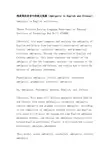
浅谈英汉语言中的歧义现象(Ambiguity in English and Chinese)Ambiguity in English and Chinese(Henan Province Foreign Language Department of Nanyang Institute of Technology Wen Weili 473066)[Abstract] this paper compares and analyses the ambiguity of English and Chinese from four aspects: phonological ambiguity, lexical ambiguity, contextual ambiguity and grammatical structure ambiguity. Through the comparison of English and Chinese ambiguity, this paper explores the causes of the ambiguity of the two languages, analyzes the features of the ambiguity in English and Chinese, and studies how to avoid the absence of ambiguous phenomena.Phonological ambiguity, lexical ambiguity, contextual ambiguity, grammatical structure, ambiguityOn, Ambiguous, Phonomena, between, English, and, Chinese[Abstract] This paper will discuss ambiguity between English and Chinese from sound amibiguity, vocabulary ambiguity, context ambiguity and grammar structure ambiguity. According to the comparison of ambiguity between Chinese and English, this paper will discuss the reasons why some English ambiguous phenomena produce, and analyse the ambiguous characteristics between English and Chinese. Finally, it will study how to avoid unnecessary ambiguous phenomena.[Key, words], sound, ambiguity, vocabulary, ambiguity, context, ambiguityGrammar structure ambiguityAuthor: Wen Weili (1955), female, Jilin province,Professor of foreign languages,, associate professor, Bachelor of English linguistics, Nanyang Institute of Technology, HenanIntroduction (Introduction)Ambiguity is a unique language phenomenon, which produces semantic fuzziness in any language use. Therefore, the study of the formation and formation of ambiguity has broad and practical significance. In reality, people restrict their ideas, convey information, express their feelings and exchange experience by means of pronunciation, intonation, mood, vocabulary and grammatical structure. In a sense, language is a special communication tool which is used by millions of people and is handed down from generation to generation and is unique to mankind. When people talk to each other, for a certain need, they often have to resort to various forms of language (body). This also explains why a language leaves a specific language environment (context), which can lead to various ambiguities.With the development of cross-cultural communication, the differences between eastern and Western cultures usually lead to misunderstanding and lead to language ambiguity. In English because of his vocabulary, words have many meanings, but the grammar is more flexible, in addition to the two languages in the expression on the difference and difference, often cause misunderstanding and ambiguity, so for English learners,language ambiguity is often encountered in learning and using English in the process of. Because of the ambiguity to express the meaning of uncertainty, can understand this, can also be understood, not determined, it affects the accuracy of language expression and effectiveness, so as to cause misunderstanding and smooth communication. This not only brings difficulties to the understanding of English, and leads to inaccurate and even wrong understanding, but also makes it difficult to translate between Chinese and English. However, if the ambiguity is used properly, it will bring a vivid sense of humor. This paper will analyze some typical ambiguity phenomena in English and Chinese, so as to better understand and use language, and play the positive role of language ambiguity to eliminate the negative influence of language ambiguity.English belongs to the Indo European language family(Indo-European family), and the Chinese language belongs to the Sino Tibetan family (Sino-Tibetan). Although English and Chinese languages are different, each with different national characteristics, but the language of all mankind as a social phenomenon, they always have some common rules of the language reflect the common things in pronunciation, vocabulary, grammatical structure, language ambiguity is the inherent characteristic of any natural language. There is ambiguity in English, and this phenomenon often occurs in chinese. The ambiguity triggered in all levels of language structure and language levels, not only triggers the internal structure of language, but also reveals the application of this structure.1. speech ambiguity (Sound, Ambiguity)Pronunciation plays an important role in English learning, and it directly affects the learners' English proficiency. Different pronunciation may lead to semantic misunderstanding, which can lead to misunderstanding and communication. English is alphabetic writing, linking and elision often leads to the emergence of phonological ambiguity.One1 ambiguity caused by changes of tone or toneA., He, is, a, nice, man.B., He, is, an, iceman.The a nice man and an I Iceman the same pronunciation, but the meaning is different, a nice man means "good", while an ice man means "retail ice man" or "iceman."The Chinese did not read, but sometimes can express different meaning through intonation changes. Rereading "get up" means "she wants to get up."." If you read "get up", it means "she forgot about it before." now she thinks of it."I, beg, your, pardon.If you change your intonation when you read this sentence, the meaning of this sentence will change. There are two explanations for this sentence:A. I beg your pardon. (said please repeat)B. I beg your pardon. (general said please forgive each other)1.2 are caused by homophone ambiguityHomophone homograph is a homonym phenomenon, as a means of speech, the spelling variation in association suggests that often lead to misunderstanding ambiguity, but if used properly, it can be used to strengthen the language transfer, help to stimulate readers' imagination, the language is humorous and witty, full of wit and humour, you can get from here, one beat the effect of.What, part, of, a, watch, do, we, use,, when, we, greet, someone?-----Hour hand.Hour hand Zhong Biao is on the watch clock, and riddle (Zhong Biao) just as a whole, and greet someone (greet sb) seems to have no relevance. If the answer in hour (hours) as our (US) is our hand (our hands), this is people the clever use of homophones (homonym) in the riddle of puns, and inspire people's minds, enhance people's thinking and imagination.The "cough" is slow (Guilong Kechuanning brand advertising)This is the one that we often see ads, borrowed Idioms "urgent" will express the concept of time "and the expression to be sick" cough "on the word, will pray to shift the focus of cough is not delayed, look for the brand Guilong Kechuanning words,euphemism, strong appeal, really played a role suggested and the advertisement, easy to memorize, memorable.The ambiguity caused by 1.3 homonymsHomonymy refers to the same pronunciation and spelling of the same and different meanings. There are many examples in both English and chinese."I, m, More, satisfied.," Moore cigarettes, I'm more satisfied."This is a classic example of Moore's cigarette in advertising language. It uses the double meaning of the word "more" skillfully: "more" is an adverb. It means "more, more"; after capitalized, it becomes a brand name. The ad makes it easy to remember the brand of the product, and it leaves a deep impression that the product is superior to the product of the same kind and can make the consumer more satisfied.Second, everything is ready except one crucial element. (Dongfeng Motor advertising)The advertisement uses a modern idiom, which happens to be the same as the brand name of the productThe wind brand has originality.2. lexical ambiguity (Vocabulary, Ambiguity)Lexical ambiguity refers to the ambiguity resulting from adifferent understanding of the meaning of a word in a sentence. English and Chinese are the two most widely used languages in the world. They have a large vocabulary and a lot of meanings, together with the cultural differences between Chinese and English. Therefore, ambiguity can be easily induced in practical use. Lexical ambiguity is often caused by polysemy or by varying parts of speech.(She, listened, with, interest, to, the, conversation, going,, on, about, her.)In this sentence, the intermediary word "about" can be interpreted as "concerning" and can be understood as "around". As the former can be understood as "she listens to others with relish, talking about herself."." If you press the latter, it can be interpreted as "she listened to the conversation of people around you with gusto."Tianjin has allocated autumn and winter cargo to North china.In this sentence, the intermediary word "Xiang" has two opposite meanings, "from" and "toward", thus causing the ambiguity of the sentence. Therefore, the sentence can have the following two meanings:A. Tianjin has allocated autumn and winter cargo from North china.B. Tianjin has allocated autumn and winter cargo to North china.I, m, very, to, glad, see, so, many, homely, faces... "This is a famous English writer Dickens once a speech in a place in the United States when he said a word. At that time, the audience burst into an uproar, second days of women who are praised in succession to him for his crimes. It turned out that "homely" in British English meant "simplicity and kindness", while in American English it contained "ugly" meaning. This is because in some English homonymous and gay words in different English speaking countries have different meaning, therefore, in English learning, we should pay attention to this point, to avoid ambiguity, misunderstanding.If you want a good skin, use a big one sooner or later.This is one of the slogans we've often seen on TV about Dabao day cream and night cream. "Sooner or later" can be a word two meaning, people can be understood as "in the morning with Dabao day cream, night with Dabao night cream", but also can be understood as "Dabao day cream and night cream" is the beauty of knowledge sooner or later the choice.3. context ambiguity (Context, Ambiguity)Context ambiguity refers to the speaker or writer of the expression of semantic content clearly, while listeners or readers in understanding due to the influence of contextual factors and produce ambiguity. Contextual ambiguity is usually produced in the communicative activities of proverbs. Sometimes implicit contexts such as social and cultural differences can also cause ambiguity.Girl:, You, remind, me, of, the, ocean. (you make me think of the ocean. )Boy:, Wild, romantic, and, restless. (crazy, romantic and active)Girl:, No, you, just, made, me, sick.. (no, you make me sick.)"Ocean" is a word here as a metaphor, different users in different contexts can have different meanings: the girl in order to express the boy's disgust, like sailing makes people sick; but the boy is understood as a kind of praise.He is going to have an operation.This sentence will have different understandings in different contexts. "He" can be the doer of the action or the receiver. If he is a child of 3 years old, that "he" is undoubtedly the patient. If you change to another scene: a doctor declines an invitation to a friend's trip because he will have an operation on a patient for second days, so you can understand: "he can't go. He's going to have an operation."." In this case, "he" is the agent.4. grammatical structure ambiguity (Grammar, Structure, Ambiguity)In practice, the phenomenon of language ambiguity is complex and diverse, and the English and Chinese language ambiguity is restricted by the syntactic structure of their own linguistic systems, and presents some differences. English grammar hasstrong system standardization. Chinese grammar emphasizes integrity, emphasis on meaning, but less form. It has a certain ambiguity and high flexibility, and brings more potential ambiguity in some ways. Through the complex ambiguity phenomenon, we can discuss its deep grammar system. Because of the generality of human language, there are similar reasons for the ambiguity in English and Chinese, and the two entirely different grammatical systems of English and Chinese make the ambiguity of English and Chinese distinctive. The causes of grammatical structure ambiguity are not only structural relations, but also semantic relations and user segmentation of structure leads to structural ambiguity. Therefore, grammatical structure ambiguity can be understood not only from semantic relations, but also from grammatical relations. It is easy to have ambiguity when segmenting the sentence structure, but there is also grammatical structure ambiguity in English as a form of sign language. Grammatical structure ambiguity is a universal phenomenon in language.4.1, ambiguity caused by different grammatical relationsThere may be more than one structural relation between different grammatical elements of the same sentence. That is, when the same word or phrase has different grammatical functions in the sentence, it can cause ambiguity. There are many examples in both English and chinese.I, saw, the, boy, crossing, the, street.In this sentence, crossing can be understood either as the present participle or as the predicate verb. Therefore, thissentence can be interpreted in the following two ways:A., I, saw, the, boy, who, was, crossing, street., theB., I, saw, the, boy, when, I, was,, crossing, the, street.We need to import tv.In this sentence, "imported television" can be viewed either as a positive structure or as a verb object structure. Therefore, the sentence will have two meanings.A. We need imported tvs.B. We need to import TV from abroad.He, hit, the, girl, with, an, umbrella.In this sentence, with an umbrella can be used either as an attribute or as an adverbial modifier. Therefore, there are two explanations for this sentence:A., He, hit, the, girl, who, was, with, umbrella., anHe hit the girl with the umbrella in her hand. )B., He, hit, the, girl, using, an, umbrella.He hit the girl with his umbrella. )4.2, the ambiguity caused by negative relationsThe scope of negation generally refers to the beginning of negative words extending from the beginning to the end of the sentence or extending to the adverbial of the latter, but sometimes the change of the scope of negation can lead to ambiguity, which is mainly manifested in two aspects, namely, total negation and partial negation. All negation means denying the affirmative relation between subject and predicate, while partial negation only denies one component of the sentence without affecting the affirmative relation between subject and predicate. Negative range ambiguity is different from negative sentence pattern.We, didn, t, run, a, hotel, on, that, account.In this sentence, when the predicate is the focus of negation, scope of negation does not include adverbial sentences, all negative, meaning "On that account, we didn t run" a hotel "; and when the adverbial when the focus of negation, scope of negation will be extended to the end of the sentence, the sentence meaning in part on that account: Not negative, did we run a hotel."I didn't lend him the English dictionary.In this sentence, when the "no" negative when the predicate "borrowed", said that all the negative sentence, what I have lent him the dictionary; when the "no" negative time attribute "English", said part of the negative sentence, "I lent him the dictionary, but not English." Therefore, if the negative word is negative, the semantic range is different, and it also causesambiguity. In addition, the negative word "no" in Chinese has two parts of speech, namely, verb and adverb, which sometimes lead to ambiguity.We didn't do bad things."No" in this sentence has two parts of speech: verb and adverb. Therefore, this sentence can be interpreted in the following two ways:A. We have nothing to do / bad things. (without adverbs, modifiers, "doing")B. We don't / do bad things. (not for verbs, modifiers, things)Ambiguity caused by 4.3 semantic relationsSemantic relation refers to the influence of interrelated and in the semantics of the sentence elements, specifically refers to action and agent, action and patient relationship, action and tools etc.. When the semantic relationship between the syntactic structure corresponding to different is ambiguous, the sentence is one of the agent and patient.The, examination, of, the, doctor, was, very, careful.In this sentence, doctor can be the agent, meaning "the doctor to check someone", and can be patient, which means "the doctor check sb". Therefore, the sentence can have the following two meanings:A., The, doctor, examined, his, patients, very, carefully.B., The, doctor, was, examined, very, carefully.She was a child born last year.In this sentence, if "she" is the "birth" of the agent, so she is my mother; if "she" is the "birth" of the patient, so she is a child.Ambiguity caused by 4.4 modifier relationsModifiers have specific modifiers and boundaries, which can lead to ambiguity when the modification becomes ambiguous.(I, met, a, friend, of, mine, wearing, a,, dirty, clothes, yesterday.)Since the wearing a dirty clothes can modify the I in this sentence, it can also be used as the post modifier of a friend of mine, so this sentence can have two meanings:A., I, met, /a, friend, of, mine/wearing, a, clothes/yesterday., dirtyB., I, met, /a, friend, of, mine, wearing,, a, dirty,clothes/yesterday.The Secretary has directed several school leaders to make new progress in the new semester.In the sentence "a few school leaders have the ambiguity," a few "can be understood as" schools ", can also be understood as the modification of" leadership ", when modifications can be replaced by the classifiers, respectively" "and" "such that the modified" school "or" leader".Conclusion (Conclusion)Mr Lv Shuxiang once said, "ambiguity is not a rare phenomenon.". The words in the dictionary are seldom polysemous except for the special nouns, and the word combinations can often be analyzed in more than one way. However, in a certain context or a certain living environment, the combination of these words or words can only have one meaning, and there are few cases of real ambiguity." This paper analyzes the causes of ambiguity in English and Chinese through four aspects: phonological ambiguity, lexical ambiguity, contextual ambiguity and grammatical structure ambiguity, and analyzes the features of the ambiguity in English and chinese;。
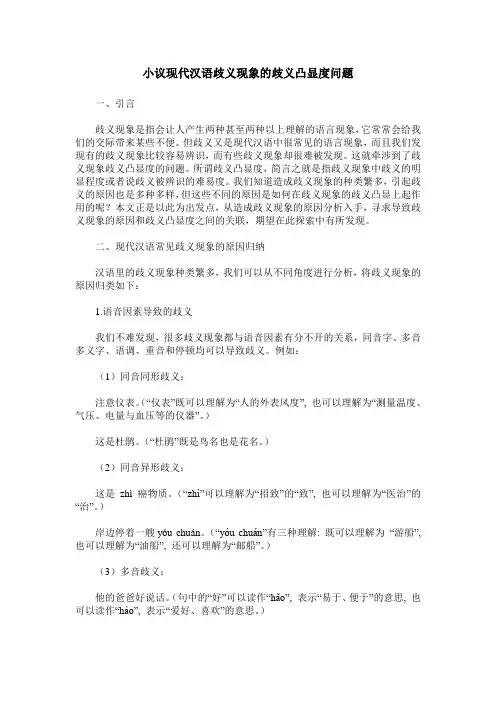
小议现代汉语歧义现象的歧义凸显度问题一、引言歧义现象是指会让人产生两种甚至两种以上理解的语言现象,它常常会给我们的交际带来某些不便。
但歧义又是现代汉语中很常见的语言现象,而且我们发现有的歧义现象比较容易辨识,而有些歧义现象却很难被发现。
这就牵涉到了歧义现象歧义凸显度的问题。
所谓歧义凸显度,简言之就是指歧义现象中歧义的明显程度或者说歧义被辨识的难易度。
我们知道造成歧义现象的种类繁多,引起歧义的原因也是多种多样,但这些不同的原因是如何在歧义现象的歧义凸显上起作用的呢?本文正是以此为出发点,从造成歧义现象的原因分析入手,寻求导致歧义现象的原因和歧义凸显度之间的关联,期望在此探索中有所发现。
二、现代汉语常见歧义现象的原因归纳汉语里的歧义现象种类繁多,我们可以从不同角度进行分析,将歧义现象的原因归类如下:1.语音因素导致的歧义我们不难发现,很多歧义现象都与语音因素有分不开的关系,同音字、多音多义字、语调、重音和停顿均可以导致歧义。
例如:(1)同音同形歧义:注意仪表。
(“仪表”既可以理解为“人的外表风度”, 也可以理解为“测量温度、气压、电量与血压等的仪器”。
)这是杜鹃。
(“杜鹃”既是鸟名也是花名。
)(2)同音异形歧义:这是zhì癌物质。
(“zhì”可以理解为“招致”的“致”, 也可以理解为“医治”的“治”。
)岸边停着一艘yóu chuán。
(“yóu chuán”有三种理解: 既可以理解为“游船”, 也可以理解为“油船”, 还可以理解为“邮船”。
)(3)多音歧义:他的爸爸好说话。
(句中的“好”可以读作“hǎo”, 表示“易于、便于”的意思, 也可以读作“hào”, 表示“爱好、喜欢”的意思。
)(4)语调歧义:你能干好吗? (这个句子分别用关切的、平淡的、嗤之以鼻的、严厉的语调来问, 依次表示关心、平淡、讽刺与指责的感情意味。
)(5)重音歧义:他又把英语复习了一遍。
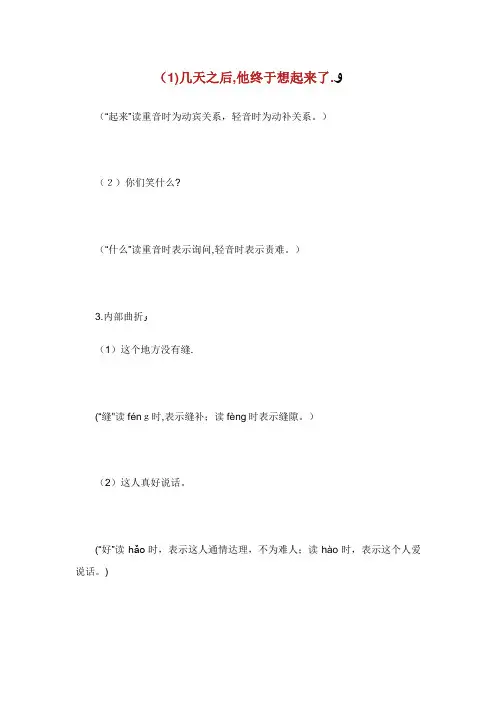
(1)几天之后,他终于想起来了.ﻭ(“起来”读重音时为动宾关系,轻音时为动补关系。
)(2)你们笑什么?(“什么”读重音时表示询问,轻音时表示责难。
)3.内部曲折ﻭ(1)这个地方没有缝.(“缝"读féng时,表示缝补;读fèng时表示缝隙。
)(2)这人真好说话。
(“好”读hǎo时,表示这人通情达理,不为难人;读hào时,表示这个人爱说话。
)以上主要是书面语情况,口语里的歧义现象主要表现在同音字上,如:你们什么时候īzhōng考试?(īzhōng是指“期中"还是指“期终”?听者肯定分不清。
)二、与词义有关的歧义ﻭ现代汉语词义组合中一部分歧义是由词义问题引起的,与引起的歧义不同,它们不仅在书面语中存在,而且在口语中同样如此。
1.词的多义性引起的歧义(1)你先坐这等着,我去买饭。
(这里的“饭”有多种含义,既可指大米饭,也可指**类煮熟食品。
)ﻭ(2)来的多半是文学院的学生。
ﻭ(“多半"既可表示数量概念“大半,超过多数”,也可表示推测“大概,也许"。
)2.由短语的多义性引起的歧义(1)这孩子样样都好,就是不会说话。
(“不会说话”既可指是哑巴,也可指交际方面不善于与人交流.)(2)大家都说他手长,我倒没发觉。
ﻭ(“手长”既可指手体细长,也可指干些小偷小摸的勾当.)3.由兼类词引起的歧义ﻭ“服务员,我的饭不热了。
”ﻭ(“热"当动词用时,表示饭不加热了;当形容词时,表示饭凉了。
)ﻭ三、与语法关系相关的歧义1.由结构关系的多重理解引起的歧义下边那根棍长三寸。
(“长三寸"既可构成主谓关系,表示长度为三寸;也可构成偏正关系,表示比较,为长度上多出三寸。
)ﻭ2.由层次关系多样性引起的歧义ﻭ高级干部俱乐部。
ﻭ(“高级干部俱乐部”一种层次是“高级"与“干部俱乐部”构成直接关系,指干部俱乐部高级;另一种是“高级干部”同“俱乐部”构成直接关系,指俱乐部是高级干部的休闲场所.)ﻭ四、与深层语义关系相关的歧义ﻭ现代汉语词义组合中,大多数情况下表层结构和深层结构是一致的,有时深层语义关系有分歧,可以在表层结构中体现出来。
歧义现象和语境研究歧义现象歧义句是指一个完整的句子同时有两种或两种以上相对完整的意思。
歧义现象在正常情况下,一个词语或句子的意思是单一的,明确的,不会使人产生误解。
但是有时某些词语或句子的表达,意思并不清楚,有几种不同的解释,究竟如何理解,令人捉摸不定,这就是遇上了歧义现象。
歧义是指语言文字两歧或多歧的意义,有两种或几种可能的解释,也即一个词语或句子在脱离语境,没有任何限制的情况下,有两种或几种不同的表达意思,模棱两可,既可这样理解,又可那样理解,语义不确定。
造成歧义的原因各不相同,歧义的类型较多,在试题中常见的主要就有以下几种:(1)词的多义:①请立即上马。
“上马”可理解为“某人跨上了马背”或“某项工程上马”。
②我买的那只灯泡早就报销了.“报销”,既可理解为“核销”,又可理解为“报废”。
(2)词类不同:①“饭不热了”,“热”是动词,意即不用热饭了,凉的也可以吃;“热”是形容词,意即饭凉了。
②“他原来住在这里”,“原来”做名词,意即他以前曾住在这里;“原来”做副词,意即没想到他就住在这个地方。
(3)结构关系不同:①进口彩电。
“进口彩电”可以是偏正关系,也可以是动宾关系;②“学生家长”,可理解为并列关系,也可理解为偏正关系。
(4)层次组合不同:①“这份报告,我写不好”,可理解为“这份报告,我/写不好(能力有限)”,也可理解为“这份报告,我写/不好(可能由于身份等因素)”。
②“我们三个人一组”,可理解为“我们/三个人一组”或“我们三个人/一组”。
(5)深层语义关系不同:①“开刀的是她父亲”,可理解为她父亲是开刀的外科医生,也可理解为他父亲有病,医生给他做了手术。
②“妇女理发店”,可能是由妇女开办的理发店,也可能是以妇女为服务对象的理发店。
(6)语境不同:①生一个最好。
对想多生子女的人来讲,“生一个最好”是劝他不要再生,一个已够了,而对不想生孩子的人来讲,是劝他生一个,不要不生;②今天星期天。
至于“今天星期天”对不同人就有可能含义大相径庭,孩子说话可以是想出去玩,妻子说这话可能是想让丈夫帮助打扫房间等等。
谈汉语的歧义现象作者:刘涛来源:《现代语文(语言研究)》2007年第08期1.概说所谓歧义,简单地说就是指一句话有两种或两种以上的理解,是一种“语富”现象。
“歧义”是包括汉语在内的许多语言都存在的一种重要语言现象。
歧义给我们的生活带来一些误解的麻烦,也为文学作品的魅力增添了奇妙的一笔,所以我们要了解歧义,掌握它的结构类型、产生原因、运用等几个方面的规律,以使它更好地为我们所用。
2.歧义的类型和原因分析歧义的类型在汉语界一直没有统一的看法。
赵元任《汉语中的歧义现象》曾对歧义现象从不同角度加以分类。
根据歧义语言片段是否出现于一定语境(上下文或现实情境)之中,把歧义分为语汇歧义与话语歧义;根据歧义语言片段引起或造成歧义的可能性的大小,把歧义分为高度歧义与低度歧义……黄德玉认为“语言中的歧义与言语中的歧解都离不开语境”,并据此把语境分为“语言内语境和语言外语境”。
我们认为现代汉语的歧义可分为两大类:语言因素产生的歧义和非语言因素产生的歧义。
下面我们具体来谈。
2.1语言因素产生的歧义语言因素涉及到语音、语义和语法,它可以细分如下:2.1.1语音2.1.1.1音同形异。
如:(1)这是一个gōngshì。
“gōngshì”这个语音形式可以表达“公式、公事、宫室” 等不同书写方式和意义,但用于书面或进入不同语境时则变成了单义,不会引起误解。
2.1.1.2音同形同这是在口头语和书面语上都易造成歧义的情况。
如:(2)请立即上马。
在书写上只有一种形式,可在意义上却可表达为:“工程上马”或“某人跨上马背”。
脱离了上下文,对句子的理解就容易产生分歧。
2.1.1.3音异形同这就是我们常说的多音字造成句子歧义的情况。
如:(3)这头发长(cháng或zhǎng)得奇怪。
这种情况只能导致书面歧义。
2.1.2语义词的语义不总是单一的,因而在表达时就可能产生各种各样的理解,即常说的一词多义引起的歧义,这是很常见的。
浅谈汉语言文字的歧义现象
浅谈汉语言文字的歧义现象
文齐跃飞
一、歧义
指说话或文字表达上有两种或几种可能的解释,如怀念人民的周总理。
二、歧义产生的原因
语言的要素包括语音、词汇、语法以及文字等,然而这些要素所包含的内容都是有限的,人类交际所需要的表达则是无限的,以有限的手段表达无限的内容,必然会出现重合和交叉,这种重合和交叉便产生了歧义。
三、歧义的类型
1词性模糊引起的歧义
①摩托车没有锁—把它锁好不就行了!动词买一把锁就行了。
名词
②铁锤锤表锤不烂—铁锤没有烂。
名词这块表很特殊,锤不烂。
动词
2结构关系不明产生的歧义
①你们领导也应该带头—你们领导同位关系你们的领导偏正关系
②我们公司正准备出口商品—出口商品动宾关系出口的商品偏正关系
3施动关系不明
①咬死了猎人的狗—猎人的狗被老虎咬死了。
被动句式就是这只狗把猎人咬死了。
主动句式
②校长也应该检查—校长也应该接受检查。
被动句式校长也应该去参加检查。
主动句式
4语音歧义
①母亲背着儿子去跳舞—ē背着è避开
②县长毛兔会议在此报到—á长毛兔ǎ县长
选自《新笑话集锦》
5方言引起的歧义
老不死—怎么老都不死骂人的话
6重读、轻读不当引起的歧义
①一天早上就写了三封信—就只,意指太少三封意指太多
②孙子在读书—轻读儿子的儿子重读春秋伟大的军事家孙武
7词义变迁引起的歧义
①还来就菊花—今欣赏菊花古喝菊花酒
②率妻子邑人来此绝境。
—古妻子和儿女今指夫人
8标点符号引起的歧义
1有个吝啬鬼要开酒店,请秀才写对联,且要合乎心意一要人丁兴旺,二要酿酒发财,三要店中无老鼠,四要养肥猪。
秀才因为平常最恨这些吝啬鬼,便挥毫写下了以下对联
酿酒缸缸好做醋坛坛酸
养猪大如山老鼠头头死
横批人多病少财富
2唐朝书画家、江南四大才子之一的祝枝山祝允明,虽出身名门豪富,却疾恶如仇,常替老百姓说话,有一财主请他写对联,他就分别在大门和二门写上明年逢春好不晦气
终年倒运少有余财
此地安能居住
其人好不伤悲
3家产归谁。
一翁临终前留下的遗言是张一非是我子家产尽归我女婿是外人不许干涉。
以上三则小故事都是众所周知的有歧义的例子,在此就无需赘述了。
张志公先生指出,歧义有两种不同的情况有一种歧义现象是难于避免的,但只要放在一定的语言环境里就没有歧义了,这称为合理歧义;另一种是即便是放在任何语言环境中仍有歧义,这称为不合理歧义。
作者单位江西省婺源县梅林中学。